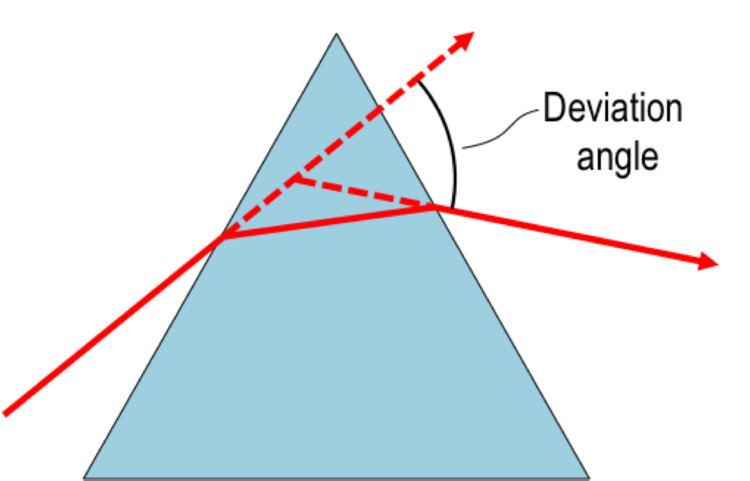 | ||
As a ray of light enters the transparent material, the ray's direction is deflected, based on both the entrance angle (typically measured relative to the perpendicular to the surface) and the material's refractive index, and according to Snell's Law. A beam passing through an object like a prism or water drop is deflected twice: once entering, and again when exiting. The sum of these two deflections is called the deviation angle.
The deviation angle in a prism depends upon:
Refractive index of the prism: The refractive index depends on the material and the wavelength of the light. The larger the refractive index, the larger the deviation angle.
Angle of the prism: The larger the prism angle, the larger the deviation angle.
Angle of incidence: The deviation angle depends on the angle that the beam enters the object, called angle of incidence. The deviation angle first decreases with increasing incidence angle, and then it increases.
There is an angle of incidence at which the sum of the two deflections is a minimum. The deviation angle at this point is called the "minimum deviation" angle, or "angle of minimum deviation". At the minimum deviation angle, the incidence and exit angles of the ray are identical. One of the factors that causes a rainbow is the bunching of light rays at the minimum deviation angle that is close to the rainbow angle.
A convenient way to measure the refractive index of a prism is to direct a light ray through the prism so it produces the minimum deviation angle. This yields a simple formula:
where n is the refractive index at a wavelength λ , D is the angle of minimum deviation, and A is the internal angle of the prism.
The angle of minimum deviation is attained when the angle of incidence and angle of emergence for a ray of light being refracted through a prism, are equal.
Also, the variation of angle of deviation with an arbitrary angle of incidence can be encapsulated into a single equation:
Where,
It may be noted that minimum deviation in a rectangular slab is zero as both the surfaces separating two media are parallel, whereas, in a prism they are inclined to each other.
